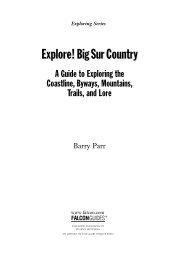A Field Guide to Poison Ivy, Poison Oak, and ... - Falcon Guides
A Field Guide to Poison Ivy, Poison Oak, and ... - Falcon Guides
A Field Guide to Poison Ivy, Poison Oak, and ... - Falcon Guides
Create successful ePaper yourself
Turn your PDF publications into a flip-book with our unique Google optimized e-Paper software.
The Toxic Trio 3<br />
cation of this rule may be appropriate for the occasional<br />
woods w<strong>and</strong>erer who is willing <strong>to</strong> remain on a beaten<br />
path. But for the nature lover who wants <strong>to</strong> get up close<br />
<strong>and</strong> friendly with local fauna, it is far <strong>to</strong>o restrictive: Many<br />
benign forest plants have three leaves, or three leafl ets.<br />
As with most easy advice, in the end even the more<br />
specifi c “leafl ets three, let it be” not only encourages<br />
excessive precaution, it does not render absolute protection.<br />
Both poison oak <strong>and</strong> ivy have compound leaves that<br />
are usually arranged in three leafl ets, but they may have<br />
up <strong>to</strong> eleven leafl ets.<br />
The person who wants <strong>to</strong> be spared two weeks of<br />
scratching as payment for a weekend in the country<br />
should not only count leafl ets but also learn <strong>to</strong> recognize<br />
leaf <strong>and</strong> plant shapes. In its usual perverse way, nature<br />
does not make this easy. <strong>Poison</strong> ivy leafl ets are usually oval<br />
<strong>and</strong> lightly <strong>to</strong>othed. <strong>Poison</strong> oak leafl ets are usually slightly<br />
lobed, like oak tree leaves. Where their ranges overlap—in<br />
the Midwest, for example—the oaks <strong>and</strong> ivies hybridize,<br />
<strong>and</strong> newcomers may be classifi ed as both. In addition, offspring<br />
from root stalks reproduce true <strong>to</strong> their source, but<br />
those from seed may go their own way. As of 1986, according<br />
<strong>to</strong> an article in Clinics in Derma<strong>to</strong>logy, the poison ivy species<br />
known as Toxicodendron radicans had nine identifi ed<br />
subspecies (sometimes called varieties or cultivars).<br />
Fortunately whatever the intricacies of their shapes,<br />
the oaks <strong>and</strong> ivies are predictably similar in other important<br />
ways. The leafl ets of both plants are usually about<br />
four inches long. Their stems are woody. Climbing varieties<br />
have visible aerial roots. The leafl ets are usually<br />
shiny—sometimes described as waxy—although they may<br />
also be dull or hairy, especially underneath. They start out<br />
a bright green <strong>and</strong> <strong>to</strong>ward late summer <strong>and</strong> fall turn yellowish<br />
or reddish, then bright red.<br />
When in bloom or gone <strong>to</strong> seed, poison oak <strong>and</strong> ivy<br />
are easier <strong>to</strong> distinguish from other plants. Variations in








